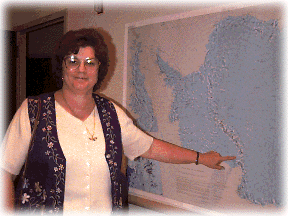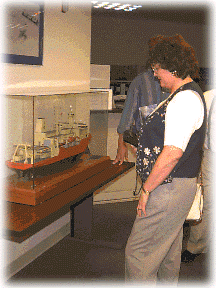
|
|





Carole Bennett of Gaither High School
in Tampa, Florida, pointing to the
location of her upcoming fieldwork!
See Carole's Expedition Pictures!

 I have taught chemistry for 31 years and teach Chemistry I Honors at a large
public high school in Tampa, Florida. Currently, I am active in a honorary
teaching sorority, Alpha Delta Kappa am a member of the American Chemical
Society. I really love teaching and think it is the most worthwhile profession
possible I have taught chemistry for 31 years and teach Chemistry I Honors at a large
public high school in Tampa, Florida. Currently, I am active in a honorary
teaching sorority, Alpha Delta Kappa am a member of the American Chemical
Society. I really love teaching and think it is the most worthwhile profession
possible
I am somewhat adventuresome. I enjoy traveling, nature photography and
hiking. I grow orchids, ferns and bromeliads and have gone to Ecuador to
collect ferns and aroids. I have gone white water rafting on the Nanthahala
River in North Caroleina, in Alaska outside Denali National Park, and on
the middle fork of the Salmon River in Idaho. I have gone hot air ballooning
in Tampa.....nothing is as awesome as floating just above the trees in a
swamp and looking at great blue herons gliding over quiet waters just after
dawn. I don't have any pets now but have raised tropical fish. I formerly
had a kinkajou, a tropical member of the raccoon family with a prehensile
tail. She was nocturnal so slept most of the say and played all night.
In November I will assist a meteorologist in collecting ice core samples
at a remote site on the Ross Ice Shelf, some
60 miles from McMurdo
Station. Dr. Braaten, my principal investigator, teaches at the University
of Kansas and is interested in snow accumulation and transport relative
to the wind velocity. A 19 year old student, Jennifer Stewart, will accompany
the team to Antarctica and will write a research paper with data she and
I collect for a separate project. Jennifer and I will study the shapes of
the ripples in the snow.
At our remote site temperature, relative humidity, atmospheric pressure,
wind speed, and wind direction are measured every 10 minutes, 24 hours a
day, 12 months a year! We will be camping in two "Scott" tents,
which are shaped like square pyramids and have strong rope ties to keep
them from blowing away in the wind. We will have to melt show to get water
for drinking and cooking!
I am excited about going to Antarctica because it is the last frontier.
So few people know much about this continent. I am happy to be part of
this fascinating experience. Just think what it will be like to stand at
a place on the ice that no one walked before.....to see the wonder of nature....to
hear only the sound of the wind as it whistles by.....to contemplate the
wonder of God's creation, Planet Earth.

Measurements and Model Development of Antarctic Snow: Accumulation and
Transport Dynamics
Investigator: David A Braaten,
University of Kansas Main Campus
 The research team I worked with is investigating snow accumulation and how the snow is transported. This research will help us understand how ice sheets grow, and, more specifically, how the Antarctic ice sheet is changing. This knowledge will help us predict how the Antarctic ice sheet may change in the future as our climate changes.
The research team I worked with is investigating snow accumulation and how the snow is transported. This research will help us understand how ice sheets grow, and, more specifically, how the Antarctic ice sheet is changing. This knowledge will help us predict how the Antarctic ice sheet may change in the future as our climate changes.
We used an instrument that automatically disperses tiny colored glass spheres onto the snow surface every 14 days. As the snow continues to accumulate, the spheres are covered. After two weeks more spheres are released into the air to fall on the snow. A different color is used each time the spheres are released. The spheres give us a time marker and tell us the wind direction. Later, we collect snow cores and look for the colored spheres so that we can reconstruct how fast the snow was accumulating between each layer of different-colored spheres. We also studied the sastrugi - wind-sculpted snow mounds - to see if they are created like sand dunes when wind blows the sand.
This is a multi-year project that will compare snow accumulation and wind-driven transport at several sites. Two sites are near the coast, where precipitation rates are much higher than in the interior of the continent. When the instruments are moved to different locations, one will be in an area of strong katabatic winds (density-driven winds that can blow well in excess of 100 miles per hour), and the other will be inland on the Polar Plateau.
Polar Classroom Activity:
Pressure
Versus Force: Landing On Ice!

December 1996
| Su |
Mo |
Tu |
We |
Th |
Fr |
Sa |
| 1 |
2 |
3 |
4 |
5 |
6 |
7 |
| 8 |
9 |
10 |
11 |
12 |
13 |
14 |
| 15 |
16 |
17 |
18 |
19 |
20 |
21 |
| 22 |
23 |
24 |
25 |
26 |
27 |
28 |
| 29 |
30 |
31 |
-- |
-- |
-- |
-- |
November 1996
Return to top of page
|







 I have taught chemistry for 31 years and teach Chemistry I Honors at a large
public high school in Tampa, Florida. Currently, I am active in a honorary
teaching sorority, Alpha Delta Kappa am a member of the American Chemical
Society. I really love teaching and think it is the most worthwhile profession
possible
I have taught chemistry for 31 years and teach Chemistry I Honors at a large
public high school in Tampa, Florida. Currently, I am active in a honorary
teaching sorority, Alpha Delta Kappa am a member of the American Chemical
Society. I really love teaching and think it is the most worthwhile profession
possible The research team I worked with is investigating snow accumulation and how the snow is transported. This research will help us understand how ice sheets grow, and, more specifically, how the Antarctic ice sheet is changing. This knowledge will help us predict how the Antarctic ice sheet may change in the future as our climate changes.
The research team I worked with is investigating snow accumulation and how the snow is transported. This research will help us understand how ice sheets grow, and, more specifically, how the Antarctic ice sheet is changing. This knowledge will help us predict how the Antarctic ice sheet may change in the future as our climate changes.